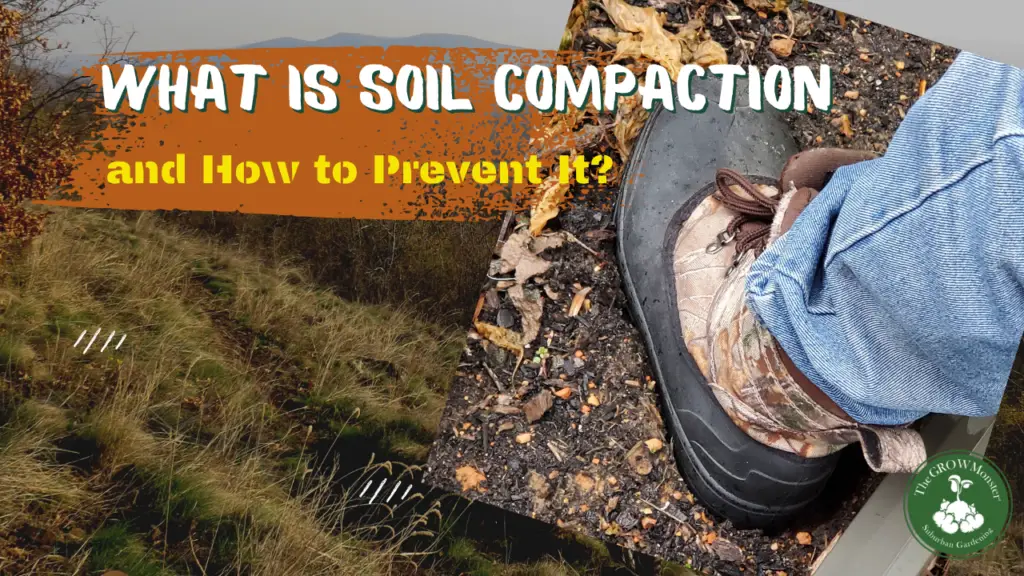Like yourself, The Grow Monster has often asked why is it difficult to grow things in some parts of the garden over others? There may be many reasons why an area of the garden proves to be difficult in growing certain plants. The typical reasons explored may include too much sun, too little sun, too much water, too little water, or possibly because of unfertile soil. However, another reason for why it is difficult to grow plants in a certain area of the garden may be due to what is called Soil Compaction.
What is Soil Compaction? Answer: soil compaction is the compression of soil particles to a point where the space between those soil particles decreases over a period of time due to human, animal, and natural activity. Soil compaction increases a soil’s density and reduces a soil’s ability to sustain plant life by reducing the aeration, water flow/drainage, and microbial activity taking place in the soil.
What is Soil Compaction?
Soil compaction is the compression of soil particles in the soil where the pore space between the particles decreases with the increase of compression. Compaction makes the soil dense. Soil compaction increases in areas where there is heavy traffic by both man and animal. If you have ever been to a school campus and noticed the foot trails etched into lawns between buildings, or trails that are used by animals in the woods, then you’ve see soil compaction at work.
Every time a foot or hoof steps on the soil, the soil is compressed under the weight and becomes a bit more dense and compact. Farmers also need to deal with soil compaction in the fields where they minimize the traffic patterns of their heavy tractors and animal traffic, which can compact the soils considerably if they are not careful.
There comes a point when plant life, organisms, and microbes are unable to grow in a highly-compacted soil, hence the clear dirt trails that are left behind from man and animal activity.
The most extreme example of compaction that The Grow Monster can provide is: cement. The particles in cement are so compacted in place that it is void of air, water, and life.
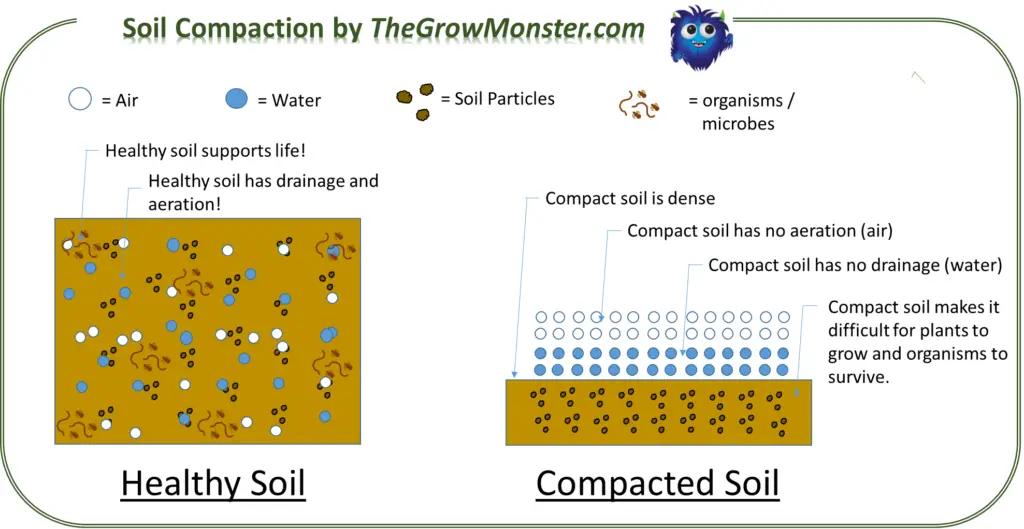
Why Do You Want to Avoid Compaction in a Garden Bed?
Soil compaction in a garden bed will have a direct impact on a plant’s ability to grow and flourish. The more compacted the soil means the more time and energy your plant’s roots will require to penetrate the soil. Seeds planted in compacted soil will have a difficult time taking root and getting established. They won’t grow to their fullest potential and will be stunted.
In compacted soil, water will tend to either pool, or will run off into the sides of the raised garden bed. This means that plants that do happen to be growing in the compacted soil will not be getting the water they need, and won’t be getting all the water that you think you have been giving them.
Check out these articles about growing plants on the Moon and growing plants on Mars to learn more about the challenges of growing plants in compacted soils.
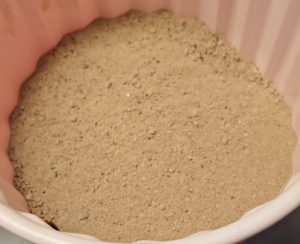
With compacted soil, the organisms and microbial life that are generally bringing nutrients to the roots will not be sustained. We know that worms benefit the garden and wear many hats including AC heating/cooling, plumbing, and composter. However, imagine being a worm trying to navigate through a densely compacted soil. It will most likely choose to burrow away from the compaction versus wasting time and energy burrowing into it.
Worms also assist with another soil requirement: aeration. When they burrow, they are building air ducts that allow the exchange of gases in the soil with the atmosphere. Their work assists the roots and the sustainment of other insect and microbial life that brings nutrients to the soil. In addition, these air ducts provide the exchange of gases (aeration) to take place in support of composting processes as well as provide the additional plumbing required to deliver water to the roots.
Compacted soils deter this worm activity, which deters aeration, which deters microbial life, which deters composting, which in the end impacts plant growth and sustainment in your garden beds.
How to reduce compaction
Now that you know what soil compaction is and why you want to avoid it, the next important part is knowing how to reduce soil compaction in your garden beds. Reducing soil compaction can begin with a couple rules from the start: the “Don’t Tread in the Bed” rule, the “Four Foot” rule, the “Don’t Work in Wet Soil” rule, the “Reduce Tilling” rule, the “Winter Crop Rule” and the “Mulching Rule”.
Don’t Tread in the Bed Rule: When it comes to the “the don’t tread in the bed rule”, this is simply advising friends and family -including yourself- to not tread inside the garden bed. This advisory is followed up with a short dissertation on what is soil compaction and why you are trying to avoid it in your garden. Foot traffic over time in a garden bed will just tamp the soil down further and further. It will go from being an aerated light and fluffy soil to becoming a soil that doesn’t drain, difficult to work in, as well as difficult to grow things in.
Imagine the amount of compaction that a one-hundred pound person could do to a garden bed over a period of time if gone unchecked!
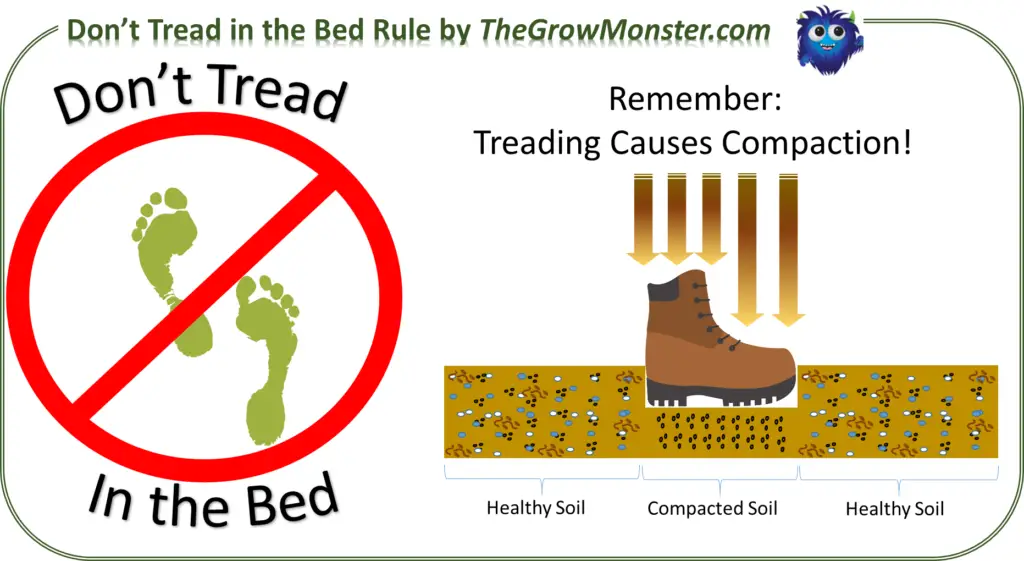
Four Foot Rule: This is very much related to the “Don’t Tread in the Bed” rule. The design and structure of your garden bed can play an important part in reducing compaction itself. In your planning and design of garden beds, you don’t want a garden bed -especially a raised garden bed- to be any wider than four feet, because anything wider than four feet will require you to step into the garden bed to work in, weed, and harvest; which in turn creates (drum roll…) compaction.
For those of you who have garden beds wider than four feet, there is a solution: stepping stones. Stepping stones in garden beds for those beds that are wider than four feet can help reduce soil compaction as the stone disperses the weight evenly into the soil beneath them. Compaction will take place only under the stepping stone and not the rest of the garden bed. Call it a ‘controlled compaction’ if you will. For those with kids, you can make it a game for them to “stay on the stones” or the ‘weed monsters’ will get them. (You can even make your own stepping stones with these stepping stone kits on Amazon).
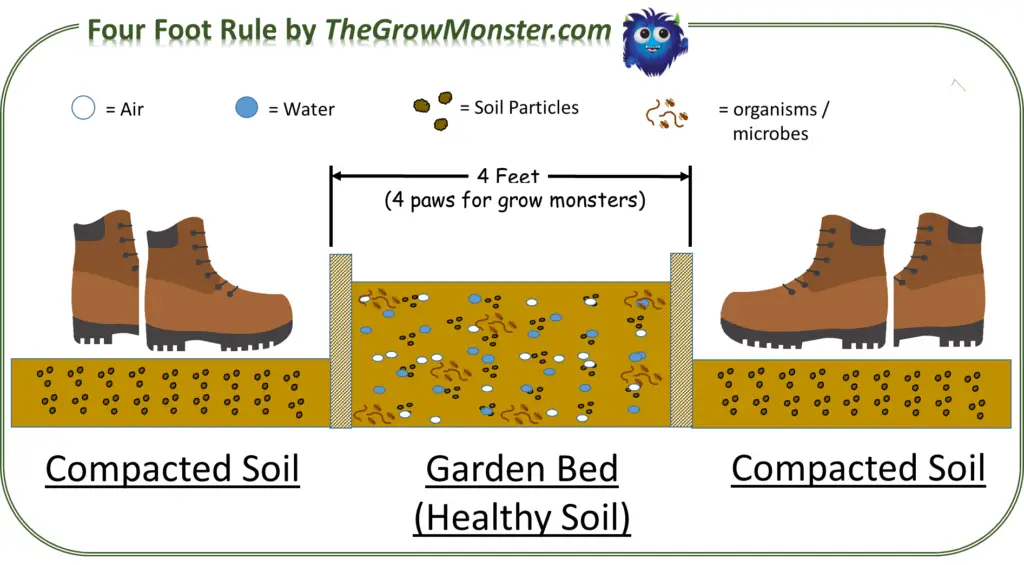
Don’t Work Wet Soil Rule:
This rule is suggesting that you wait for the garden soil to dry out a bit before working it. We mentioned earlier that cement is the most extreme example of soil compaction that we can provide. Well, we know that water is one important ingredient in making cement. When mixing cement, water is added to the powder to make a muddy slurry that -when dried- results into a rock-hard concrete. The same can be said about working with wet garden soil, especially for soils that are high in clay content.
Working in wet soils will compress soil particles together as they are moved and mixed around. Add foot traffic and pressure from your garden implements and you have the recipe for what some farmers call a ‘clod’. Clods are clumps of compacted soil that frustrate both the farmer and gardener alike. Those are pieces that seeds can’t germinate in and plants can’t grow in. Clods act like chunks of rock that a gardener will have to break up, rake up, and move out of the way to get to the soil beneath them.
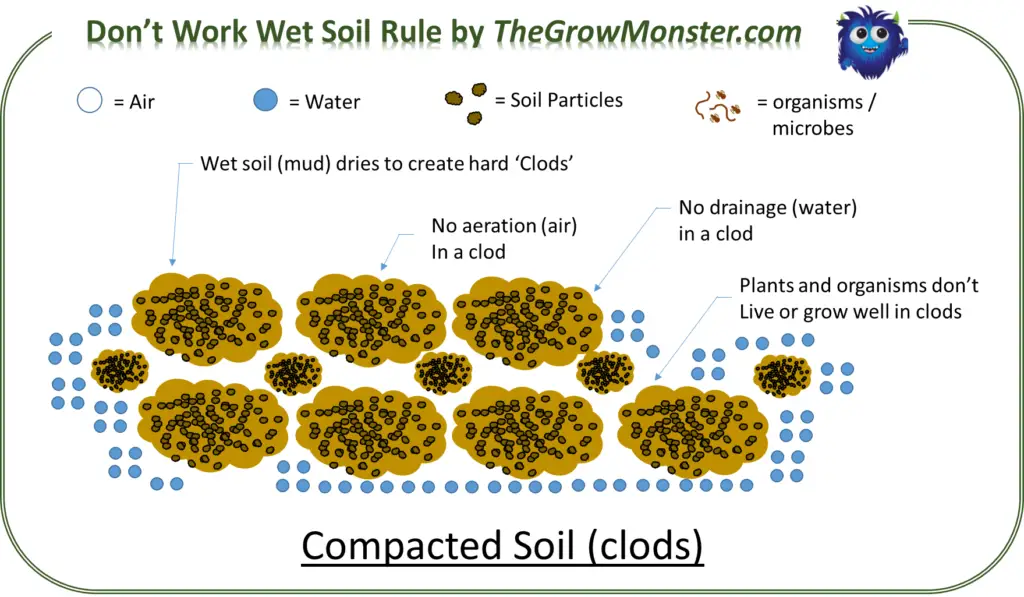
Reduce Tilling Rule
This rule seems contrary to what we have conventionally believed about gardening. Some of us have ritually tilled our garden beds each year. We see farmers tilling the fields and they have tiller machines and equipment at the home improvement stores, so why are you asked not to till? Answer: the soil is a living complex system that needs to be built up over time and the less you till it, the more fertile and less compacted it becomes.
Let your soil become the living, complex system that it was meant to become. There are fungi, worms, ant colonies and other organisms establishing themselves in the soil. Tilling displaces, injures and harms the organisms of the soil that make it fertile.
Many commercial farmers have to till the fields because they need to till fertilizers into an otherwise chronically unfertile and depleted soil system. Because heavy equipment is also used to do the work in the field, the soil is constantly compacted and tilling is required to break up the soil again in between uses. Even then, the tilling is only de-compacting soil as deep as the tiller tool itself. All the soil that the tiller doesn’t reach continues to compact over time with the continued use of the equipment.
The reason why you don’t want to till your suburban garden with a tiller begins with a question: where is the tiller in relation to you, the Gardner? The commercial tillers attached to tractors generally follow the tractor which tills up the compacted soil left behind the tractor wheel. While the tractor wheel creates soil compaction, the tractor tiller de-compacts it.
With the tiller rentals at the home improvement stores, those are heavy pieces of equipment that generally pulls the gardener forward over the tilled garden bed, compressing the soil again to an extent with both the weight of the equipment and the gardener’s own foot traffic – already violating the ‘Don’t Tread in the Bed‘ rule.
If you feel that you need to till one last time after reading this, then go ahead <insert hand slap here>, but don’t do it again. May as well till in as much lawn and yard waste of leaves and grass clippings that you can muster to provide nutrients for any organisms attempting to re-establish themselves in the soil. Then leave it be, and let it evolve. If you follow the above rules along with the rules that follow, you shouldn’t have to till the garden bed ever again, as compaction should no longer be a problem.
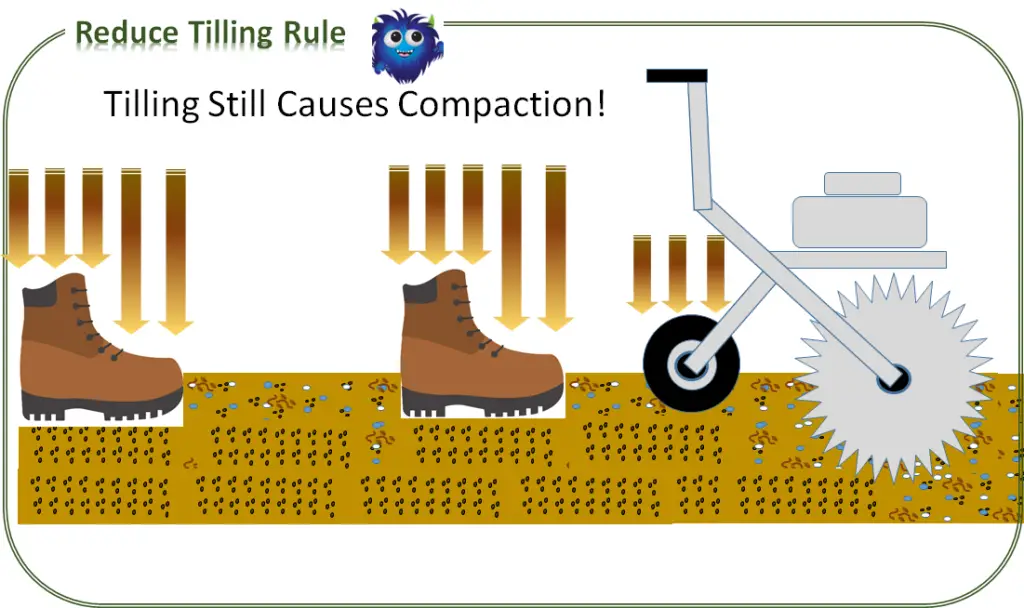
Winter Crop Rule
Before The Grow Monster started really getting into gardening, we did not know about this idea called ‘winter crops’. Like many other people, we thought things just are not supposed to grow during the winter. However, this isn’t the case. We do have have a separate post called the The Definitive Guide on Winter Sowing Using Milk Jugs if you’d like to learn more about getting a head start on your gardens before spring.
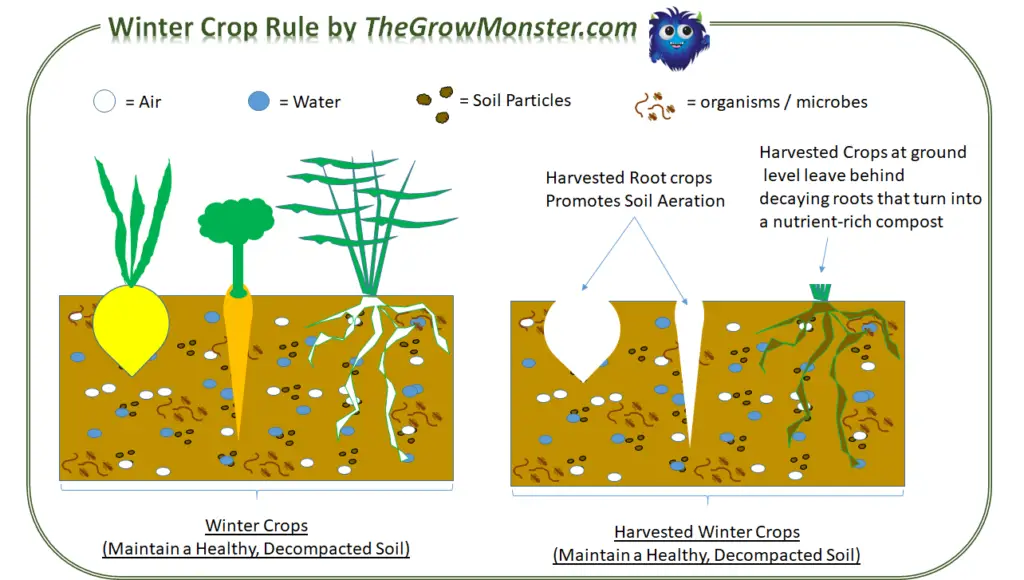
Now back to soil compaction. To reduce future compaction and to keep your soil fertile – use winter crops in the garden beds. If you use winter root crops such as carrots, onions, garlic, and radishes, those are perfect for reducing the compaction of soil. As the roots work their way into the soil, they also will act to de-compact and aerate the soil when harvested. When the root crop is harvested in the spring, the open cavities in the soil that result will provide a fine, aerated soil for the spring and summer crops that follow.
Other types of winter crops such as kale, cabbage, and spinach can be harvested at ground level leaving the roots in the ground to decompose into compost, de-compacting the soil as well as providing nutrients for the spring and summer crops that follow as well.
Mulching Rule
This rule is pretty basic: always have mulch on the garden bed. If you leave your soil directly exposed, it will start to compact from some of nature’s elements of sun and rain. When rain falls directly on the bare soil, it will start to compact naturally (see Don’t Work Wet Soil rule.) When direct rain exposure is followed up with direct sun exposure you will soon notice that you will have clods to work with as the sun dries the clumps of mud together into bigger, harder chunks of soil that plants can’t grow in.
What you need to do is always protect the surface of your soil with mulch. Mulch may include grass clippings, leaf clippings, or wood chips. What mulch does is retain the moisture in the soil so that it does not dry out, insulates the soil from extreme temperatures, provides protective cover for organisms in the soil (e.g., worms, ants, etc.), and eventually turns into a layer of nutritious compost for future generations of crops to feed.
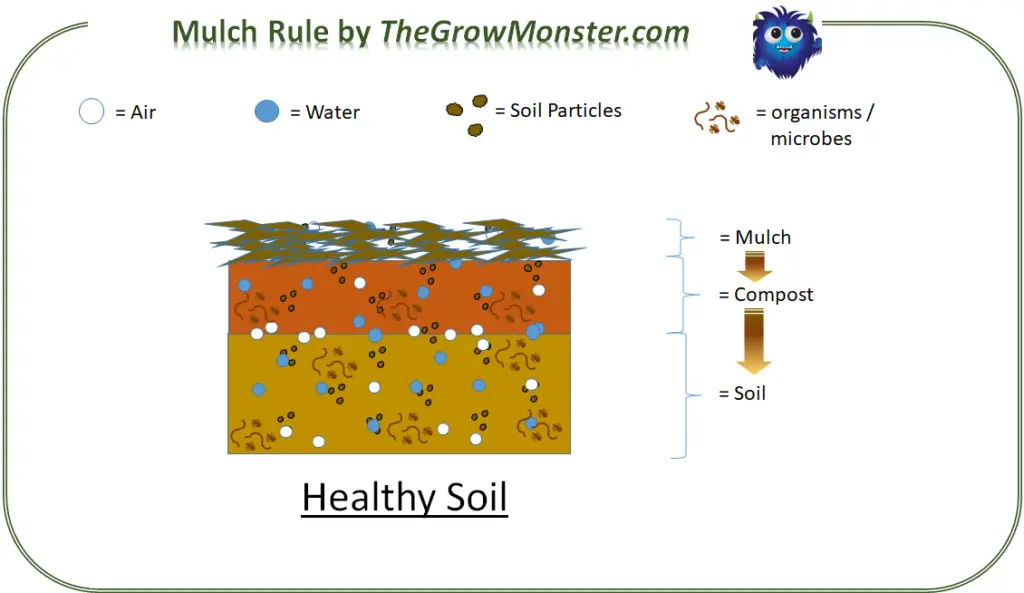
The “Build Back Better / Make Soil Great Again” Rule
We can be diplomatic and agree that soil compaction is not good for our garden. Coming to this agreement is a good first step into reducing soil compaction in the future. You can implement some or all of the rules listed above. Some people love tilling whereas other people don’t till. Some people prefer mulching whereas others do not. Implementing some or all the rules will be a good step in the right direction.
When is soil compaction good?
We have explored in this post that when it comes to getting plants to grow in the garden, soil compaction is not going to be your friend. However, we should at least acknowledge when soil compaction can be your friend. Soil compaction is an important element in construction.
Soil compaction is good for roads.
When roads are being prepared, the soils are compacted with a steam roller to press out as much air and water as possible in preparation for the asphalt and cement that follows. Who wouldn’t want to drive on a solid road supported by soil compaction?
Soil compaction is good for stone pavers/pathways
When stone paver path and walkways are being constructed, the soil has finer sand added and compacted using a tamping tool. This assists both with providing an even/stable surface to lay the pavers as well as a compacted soil in reducing the number of weeds that may grow in between the pavers. Who wouldn’t want to walk on a solid brick paver pathway supported by soil compaction?
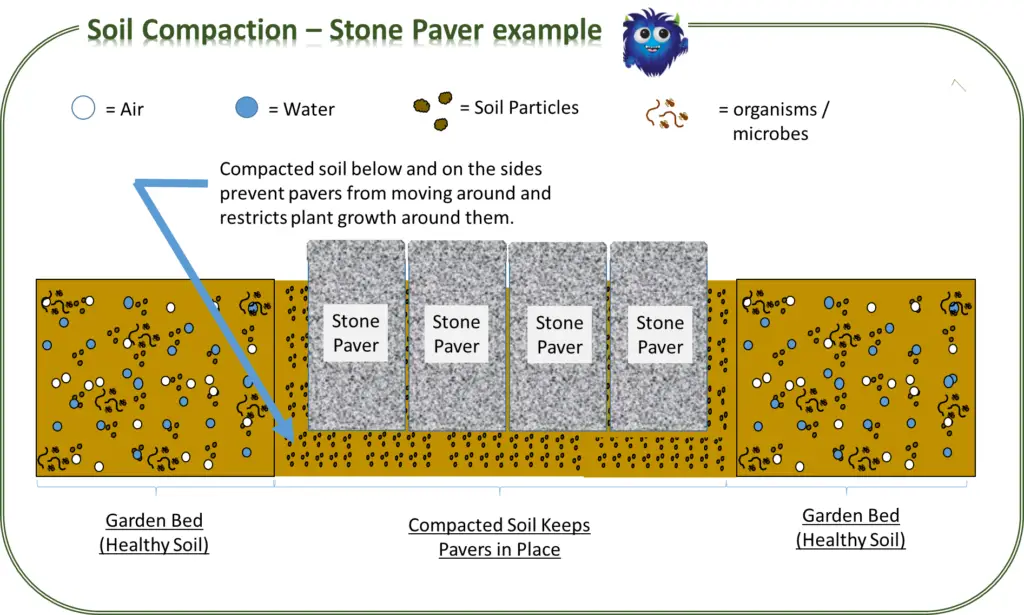
Soil compaction is good for fence posts
If you put in a fence post or other type of post without the use of cement, it is a good idea to use the blunt end of a shovel handle to tamp the dirt in and around the post (compacting the soils around it) as the dirt is filled in so that the post does not easily wobble in place. In some cases, compacting the soil itself around the post is the preferred method over concrete.
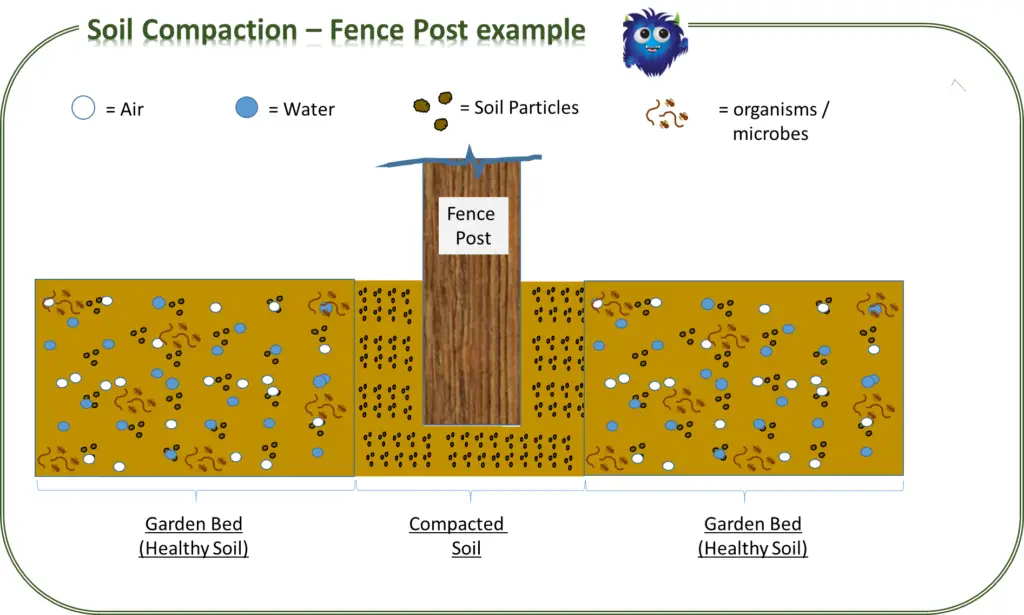
Compacted soils provide a good foundation for the construction that resides on top and around around it.
Final Thoughts
When we first started gardening, we didn’t know soil compaction was as big an issue as it was. We always blamed either the amount of sun light, temperature, water or the soil’s general fertility conditions when things were not growing well in the garden. Adopting the few simple rules listed here in your garden will at least help you to rule out soil compaction as a culprit when your garden isn’t performing as well as expected in the future. In this post we also provided examples for when soil compaction is actually beneficial.
If you want to learn more about soil compaction, the United States Department of Agriculture has an interesting paper to read called “The Biology of Soil Compaction”.

